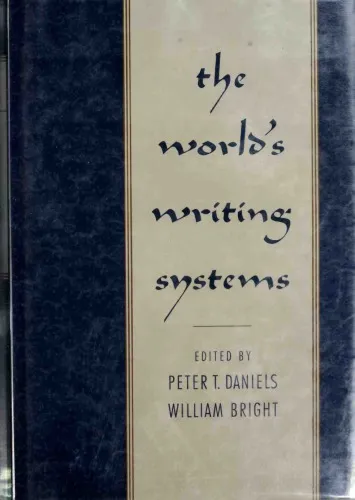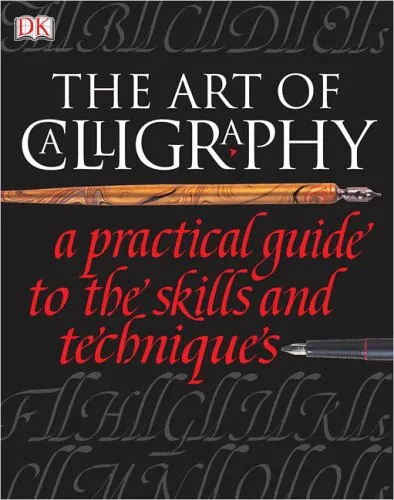Handbook of Scripts and Alphabets
4.5
Reviews from our users

You Can Ask your questions from this book's AI after Login
Each download or ask from book AI costs 2 points. To earn more free points, please visit the Points Guide Page and complete some valuable actions.Related Refrences:
Introduction to the 'Handbook of Scripts and Alphabets'
Language is one of humanity’s greatest achievements, and the systems used to record and transmit it through writing are as diverse as the cultures that created them. The 'Handbook of Scripts and Alphabets' is a comprehensive guide that explores the rich tapestry of scripts and writing systems from around the world and throughout history. It serves as a valuable resource not only for linguists and language enthusiasts, but also for those interested in human history, art, and culture. This book provides readers with a deep understanding of how writing systems evolved, their structures, and their cultural significance.
Written by George L. Campbell, the book combines scholarly research with an accessible writing style to appeal to a wide audience. Whether you are examining ancient pictographic systems such as cuneiform or delving into modern alphabets like Latin and Cyrillic, this handbook offers a treasure trove of knowledge. It not only illustrates the forms of various scripts but also sheds light on their historical contexts and linguistic foundations, making it as educational as it is fascinating.
Detailed Summary of the Book
The 'Handbook of Scripts and Alphabets' is divided into sections that cover the world’s writing systems, from prehistoric markings to modern alphabets. Beginning with the origins of writing, the book discusses iconic scripts such as Sumerian cuneiform and Egyptian hieroglyphs, which were among the first systems developed for recording language. It highlights the early evolution of writing, emphasizing how these systems enabled the transfer of knowledge and organized societies.
Moving through history, Campbell meticulously details scripts that have shaped linguistic and cultural practices, including Greek, Hebrew, Arabic, Chinese, and Indian scripts. Each chapter includes charts and tables that depict letters and their corresponding phonetic sounds, making it easy to understand the relationships between script, sound, and meaning. The book also delves into lesser-known scripts such as Georgian, Armenian, and various Native American writing systems, bringing attention to their significance in their respective cultures.
One of the standout features of the book is its discussion of the dynamics of script evolution, particularly the ways in which ancient writing systems gave birth to the alphabets we use today. Beyond their physical forms, the book explores underlying principles such as syllabaries, abjads, alphabets, and logograms, offering a clear and logical framework for understanding the diversity of global scripts.
Key Takeaways
- Scripts are not mere tools for communication; they carry rich historical and cultural symbolism.
- All modern alphabets can trace their roots to ancient prototypes such as Phoenician and Greek scripts, showcasing a deep linguistic interconnectedness.
- Writing systems reflect the evolution of societies, revealing their needs, technologies, and worldviews at distinct historical points.
- The study of alphabets and scripts fosters a deeper understanding of language, history, and human cognition.
- Preserving and studying endangered scripts is as essential as the preservation of spoken languages, as they are vital to cultural identity.
Famous Quotes from the Book
"Scripts are the living pulse of human civilization—they enable the transmission of thought across time and space."
"To understand a script is to delve into the mind of its creators, to glimpse their world as they saw it."
"The shapes of letters are not random; they are deeply rooted in historical necessity and cultural artistry."
Why This Book Matters
The 'Handbook of Scripts and Alphabets' is more than an encyclopedic reference—it is a compelling celebration of human ingenuity and creativity. At a time when digital communication continuously evolves words and symbols, it is important to understand the deep historical and cultural roots of writing systems. With so many scripts at risk of falling into obscurity, this book serves as a reminder of the value of linguistic diversity and the importance of preserving our collective heritage.
Furthermore, the book provides a crucial tool for linguists, educators, and historians, offering insights that foster interdisciplinary research. Its structured approach makes it equally useful for self-study or academic purposes, bridging the gap between scholarship and general interest. By offering both knowledge and inspiration, the 'Handbook of Scripts and Alphabets' encourages readers to explore the fascinating world of scripts, where every character carries with it the legacy of human achievement.
Free Direct Download
You Can Download this book after Login
Accessing books through legal platforms and public libraries not only supports the rights of authors and publishers but also contributes to the sustainability of reading culture. Before downloading, please take a moment to consider these options.
Find this book on other platforms:
WorldCat helps you find books in libraries worldwide.
See ratings, reviews, and discussions on Goodreads.
Find and buy rare or used books on AbeBooks.
1297
بازدید4.5
امتیاز0
نظر98%
رضایتReviews:
4.5
Based on 0 users review
Questions & Answers
Ask questions about this book or help others by answering
No questions yet. Be the first to ask!







